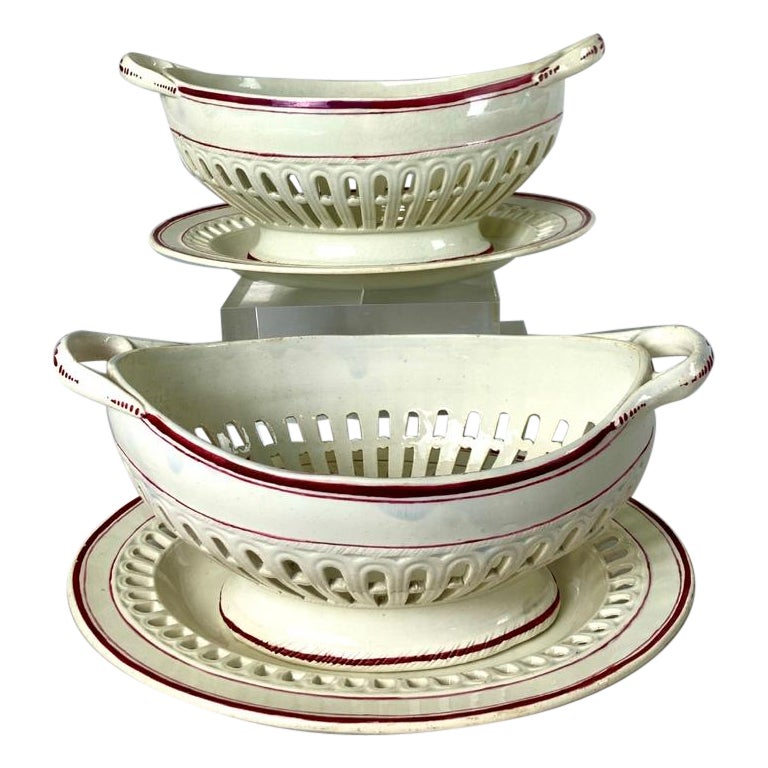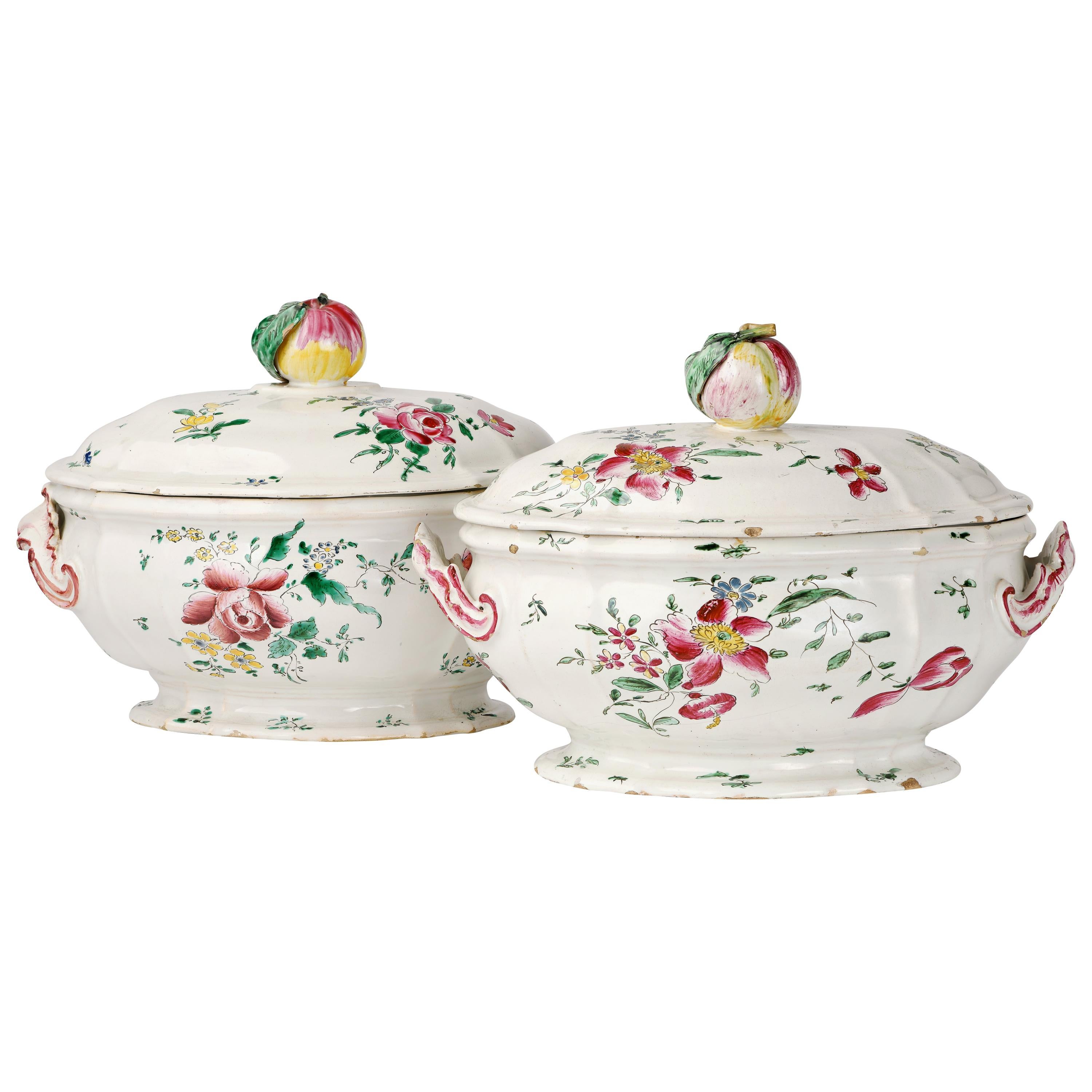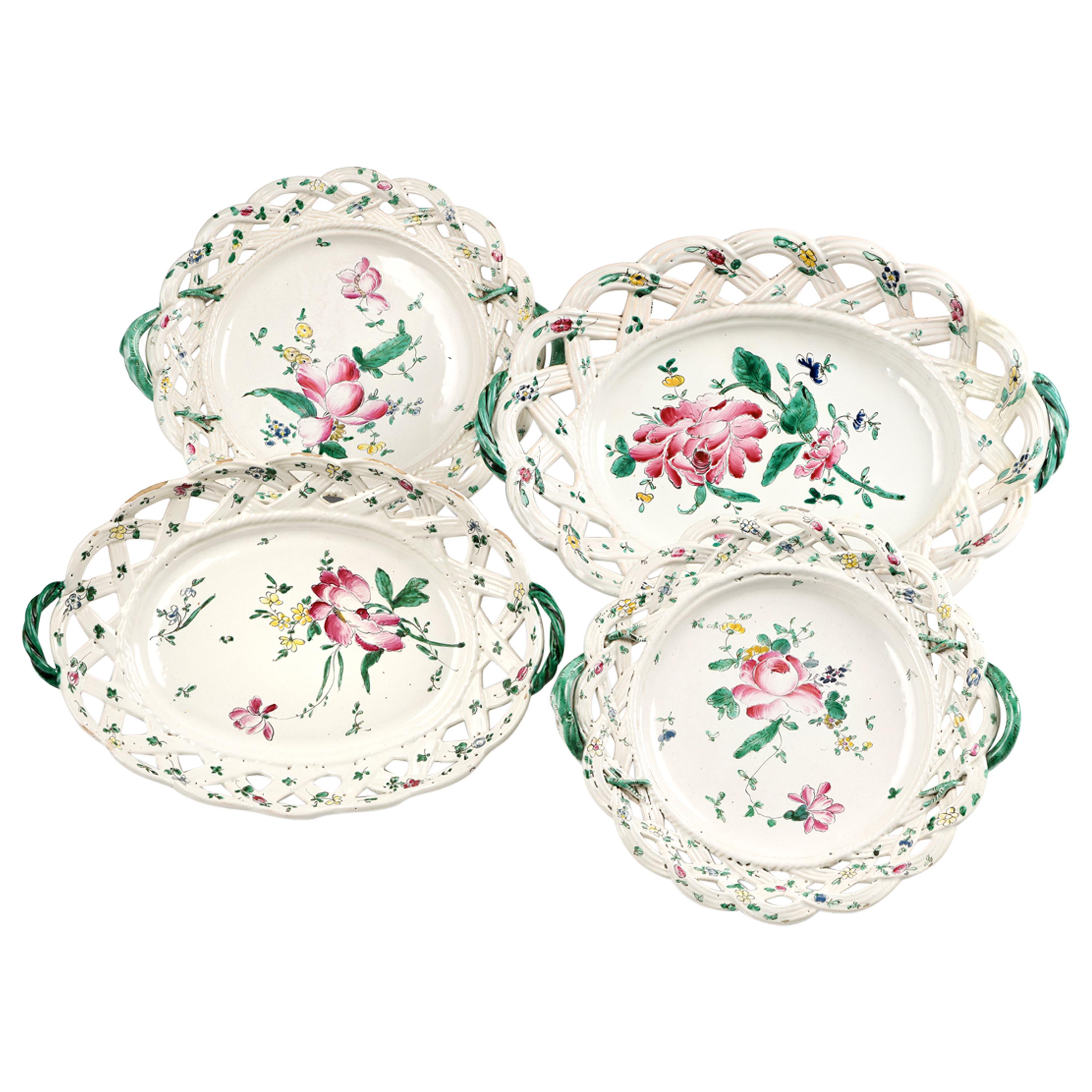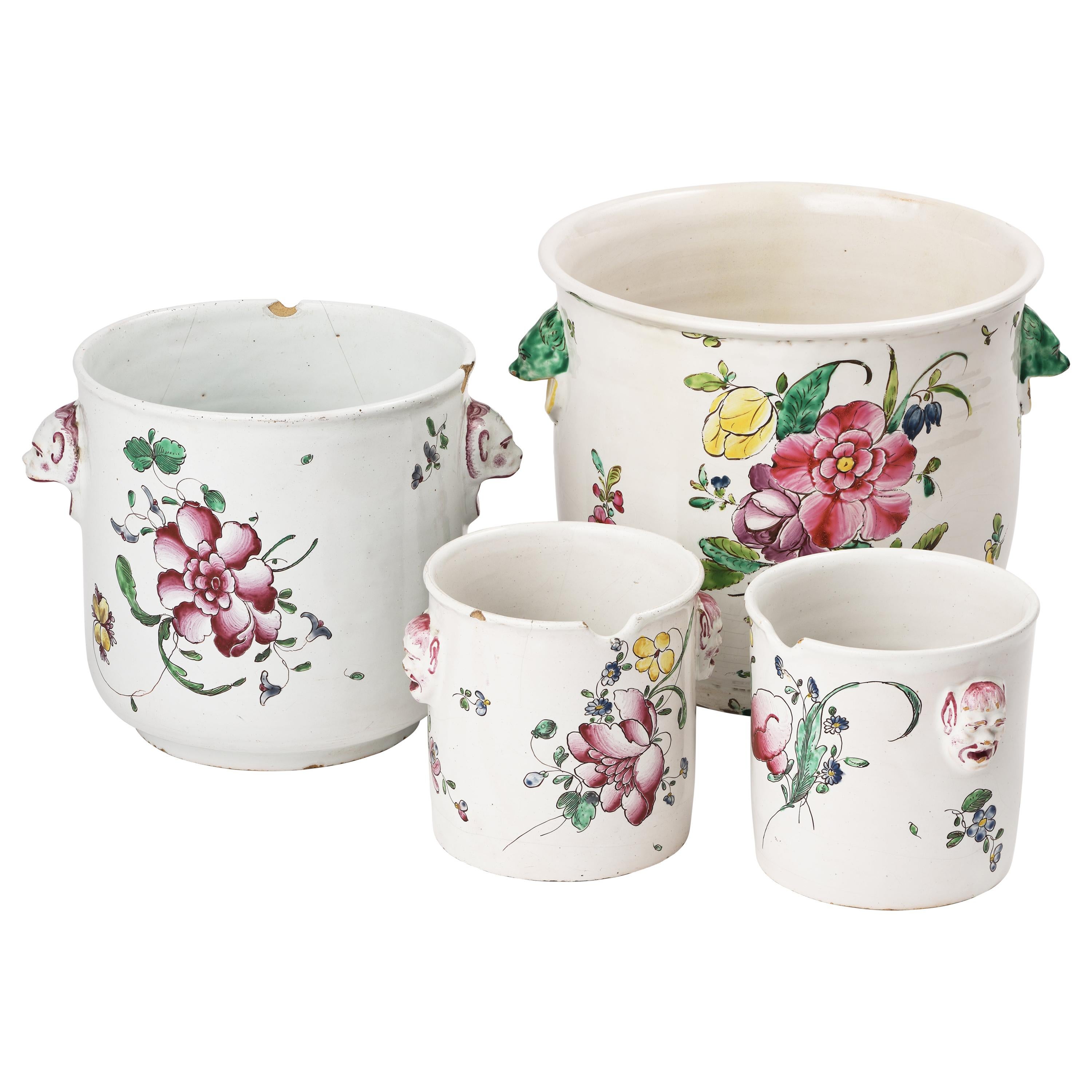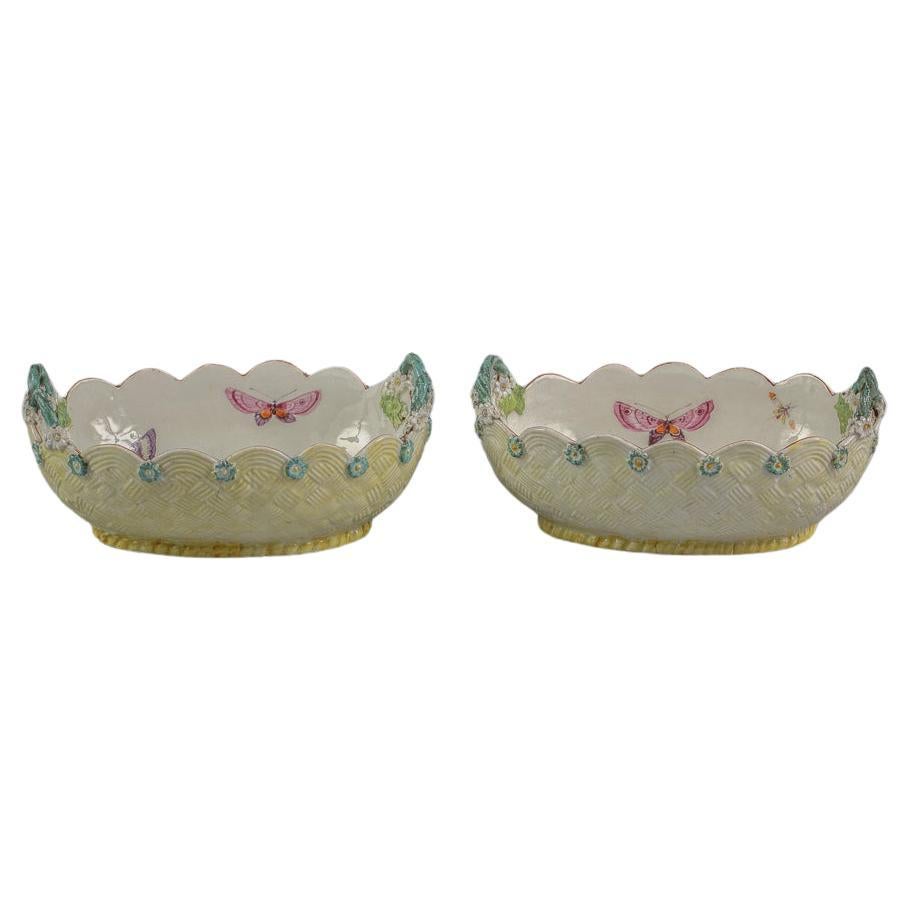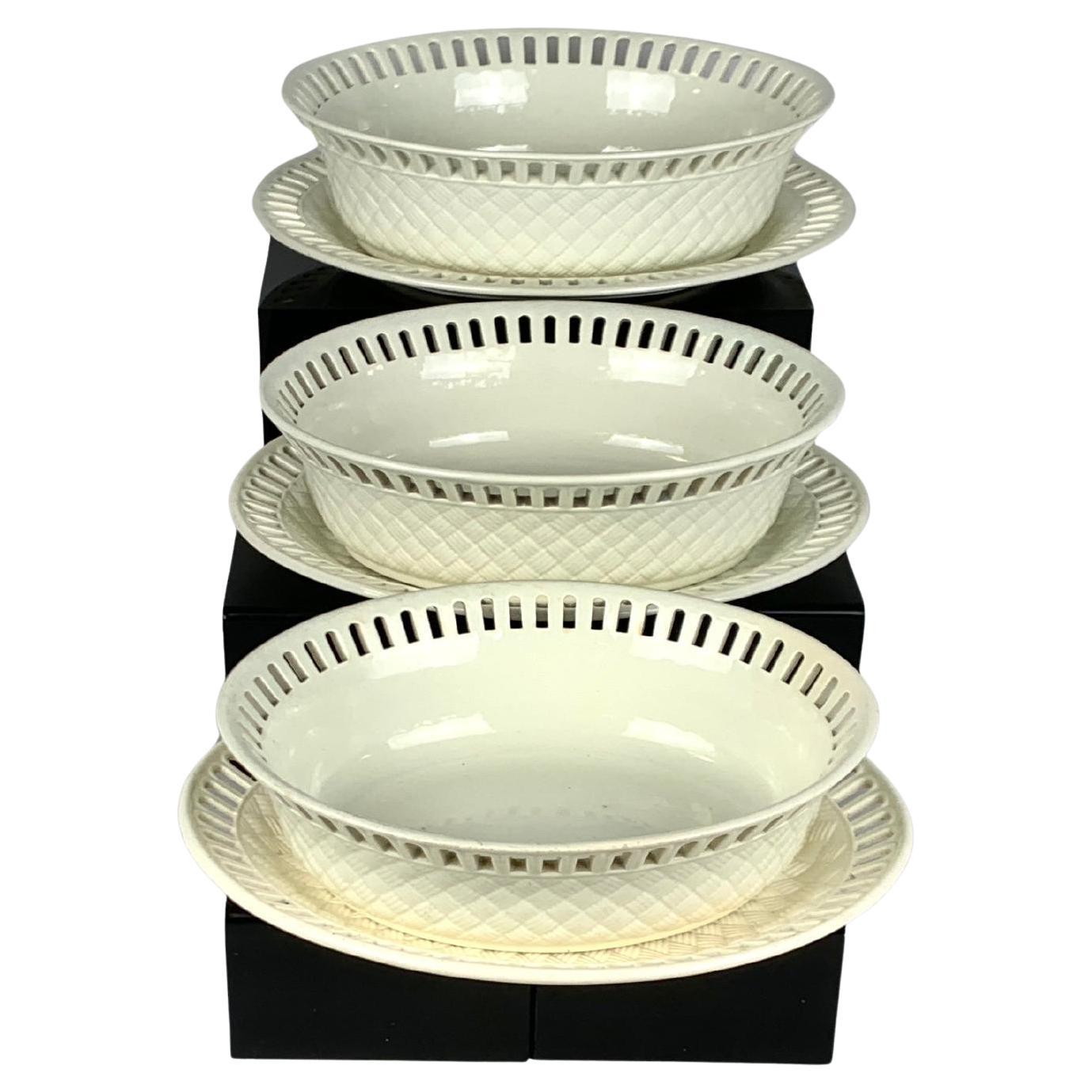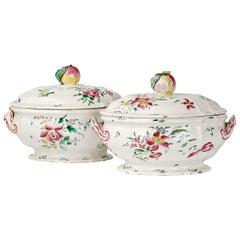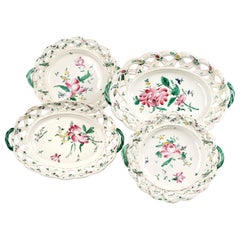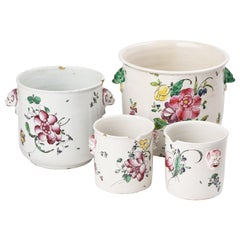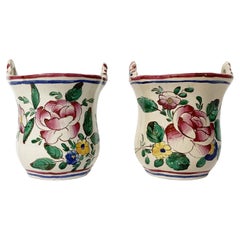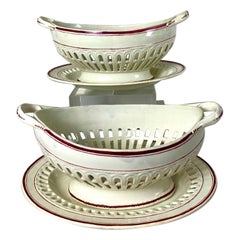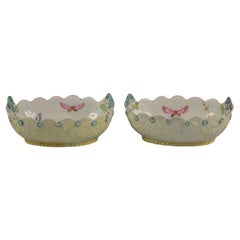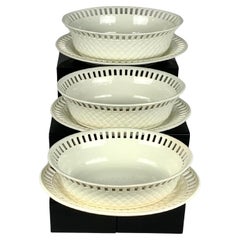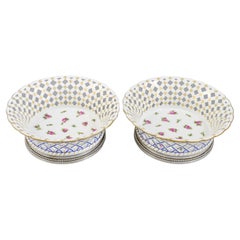Items Similar to Two Pairs of Italian Maiolica Baskets, circa 1780
Video Loading
Want more images or videos?
Request additional images or videos from the seller
1 of 20
Two Pairs of Italian Maiolica Baskets, circa 1780
$4,780.33per set
£3,538.89per set
€4,000per set
CA$6,614.79per set
A$7,291.54per set
CHF 3,815.28per set
MX$89,464.89per set
NOK 48,026.81per set
SEK 44,912.66per set
DKK 30,455.98per set
About the Item
Two pairs of maiolica baskets
Antonio Ferretti Manufacture
Lodi, circa 1770-1790
Maiolica polychrome decorated “a piccolo fuoco” (third fire).
Measures: A) Height 3.54 x 6.69 x 9.84 in (9 x 17 x 25 cm);
B) Height 3.93 x 7.48 x 11.02 in (10 x 19 x 28 cm).
Total weight 4.85 lb (2.200 kg)
State of conservation:
A) One of the smaller baskets has some areas of restoration, the other slight chipping from use;
B) One of the larger baskets is intact and the other shows a clearly glued break.
The mold with which the baskets were forged simulates a wicker weave.
The two larger works have high, vertical walls, with branch-shaped handles penetrating the weave. The painted decorations, small polychrome flowers applied only externally, highlight the points where the weaves intersect.
The decision to leave the center of the basket devoid of decoration is highly unusual, but given the size and complexity of the shape, as well as the quality of the enamel, it is possible to hypothesize that it represents a precise choice in manufacturing or for a particular client.
The two smaller baskets have small, twisted handles and, on the outside, reproduce more decisively the characteristic wicker weave, obtained through thin molded lines. The interior exhibits a rich, typical decoration of naturalistic flowers: a bunch centered around a main flower and secondary stems accompanied by small “semis”. The exterior of these works is also adorned with small little flowers where the weaves intersect.
The size and morphological characteristics of the baskets confirm their attribution to the Lodi factory of Antonio Ferretti between 1770 and 1790, during its most successful period; by this point his original reworking of the "Strasbourg" decoration, known as "old Lodi", had achieved great fame even outside Italy.
This decorative choice represented a strong point of the Lodi factory, which established itself thanks to the vivid nature of the colors made possible by the introduction of a new technique perfected by Paul Hannong in Strasbourg and which Antonio Ferretti introduced in Italy. This production process, called “piccolo fuoco” (third fire), allowed the use of a greater number of colors than in the past; in particular, the purple of Cassius, a red made from gold chloride, was introduced. Its use allowed for many more tones and shades, from pink to purple.
The Ferretti family had started their maiolica manufacturing business in Lodi in 1725.
The forefather Simpliciano had started the business by purchasing an ancient furnace in 1725 and, indeed, we have evidence of the full activity of the furnaces from April of the same year (Novasconi-Ferrari-Corvi, 1964, p. 26 n. 4). Simpliciano had started a production of excellence also thanks to the ownership of clay quarries in Stradella, not far from Pavia. The production was so successful that in 1726 a decree of the Turin Chamber came to prohibit the importation of foreign ceramics, especially from Lodi, to protect internal production (G. Lise, La ceramica a Lodi, Lodi 1981, p. 59).
In its initial stages, the manufacture produced maolicas painted with the “a gran fuoco” (double fire) technique, often in turquoise monochrome, with ornamentation derived from compositional modules in vogue in Rouen in France. This was also thanks to the collaboration of painters like Giorgio Giacinto Rossetti, who placed his name on the best specimens next to the initials of the factory.
In 1748 Simpliciano made his will (Gelmini, 1995, p. 30) appointing his son Giuseppe Antonio (known as Antonio) as universal heir. After 1750, when Simpliciano passed away, Antonio was directly involved in the maiolica factory, increasing its fortunes and achieving a reputation on a European level. Particularly important was the aforementioned introduction in 1760 of the innovative “a piccolo fuoco” (third fire) processing, which, expanding the ornamental repertoire with Saxon-inspired floral themes, could commercially compete with the German porcelains that had one of its most renowned offerings in the naturalistic Deutsche Blumen. Antonio Ferretti understood and promoted this technique and this decoration, proposing it in a fresher and more corrective version, less linked to botanical tables, both with or without contour line, as well as in purple or green monochrome. After efforts to introduce more industrial production techniques to the sector succeeded, even the Ferretti manufacture, in the last decade of the eighteenth century, started heading towards decline despite its attempts to adapt production to neoclassical tastes.
In 1796 the Napoleonic battle for the conquest of the Lodi bridge over the Adda definitively compromised the furnaces. Production resumed, albeit in a rather stunted manner, until Antonio's death on 29 December 1810. (M. L. Gelmini, pp. 28-30, 38, 43 sgg., 130-136 (for Simpliciano); pp. 31 sgg., 45-47, 142-192 (for Antonio).
Similar specimens can be found in the main Lombard public and private collections: a tureen of the same model is kept in Lodi, in the collections of the Civic Museum (Maioliche di Lodi, Milano e Pavia (catal.), Milano 1964, n. 127).
Bibliography for comparison:
C. Baroni, Storia delle ceramiche nel Lodigiano, in Archivio storico per la città e i comuni del circondario e della diocesi di Lodi, XXXIV (1915), pp. 118, 124, 142; XXXV (1916), pp. 5-8;
C. Baroni, La maiolica antica di Lodi, in Archivio storico lombardo, LVIII (1931), pp. 453-455;
L. Ciboldi, La maiolica lodigiana, in Archivio storico lodigiano, LXXX (1953), pp. 25 sgg.;
S. Levy, Maioliche settecentesche lombarde e venete, Milano 1962, pp. 17 sgg.;
A. Novasconi - S. Ferrari - S. Corvi, La ceramica lodigiana, Lodi 1964, ad Indicem; Maioliche di Lodi, Milano e Pavia (catal.), Milano 1964, p. 17;
O. Ferrari - G. Scavizzi, Maioliche italiane del Seicento e del Settecento, Milano 1965, pp. 26 sgg.
- Creator:Antonio Ferretti (Manufacturer)
- Dimensions:Height: 3.94 in (10 cm)Width: 11.03 in (28 cm)Depth: 7.49 in (19 cm)
- Sold As:Set of 4
- Style:Neoclassical (Of the Period)
- Materials and Techniques:Maiolica,Glazed
- Place of Origin:
- Period:1770-1779
- Date of Manufacture:circa 1780
- Condition:Repaired: They are old restorations, probably made around the 80s. A) One of the smaller baskets has some areas of restoration, the other slight chipping from use; B) One of the larger baskets is intact and the other shows a clearly glued break. Minor structural damages. A) One of the smaller baskets has some areas of restoration, the other slight chipping from use; B) One of the larger baskets is intact and the other shows a clearly glued break.
- Seller Location:Milano, IT
- Reference Number:1stDibs: LU4352222417532
About the Seller
4.3
Vetted Professional Seller
Every seller passes strict standards for authenticity and reliability
Established in 1860
1stDibs seller since 2018
21 sales on 1stDibs
Associations
International Confederation of Art and Antique Dealers' Associations
- ShippingRetrieving quote...Shipping from: Milano, Italy
- Return Policy
Authenticity Guarantee
In the unlikely event there’s an issue with an item’s authenticity, contact us within 1 year for a full refund. DetailsMoney-Back Guarantee
If your item is not as described, is damaged in transit, or does not arrive, contact us within 7 days for a full refund. Details24-Hour Cancellation
You have a 24-hour grace period in which to reconsider your purchase, with no questions asked.Vetted Professional Sellers
Our world-class sellers must adhere to strict standards for service and quality, maintaining the integrity of our listings.Price-Match Guarantee
If you find that a seller listed the same item for a lower price elsewhere, we’ll match it.Trusted Global Delivery
Our best-in-class carrier network provides specialized shipping options worldwide, including custom delivery.More From This Seller
View AllPair of Italian Maiolica Tureens, Ferretti Manufacture, Lodi Circa 1770 - 1780
By Antonio Ferretti
Located in Milano, IT
Pair of maiolica tureens
Antonio Ferretti Manufacture
Lodi, circa 1770-1780
Maiolica polychrome decorated “a piccolo fuoco” (third fire).
a – 8.66 x 11.02 x 7.48 in (22 x 28 x 19...
Category
Antique 1770s Italian Rococo Ceramics
Materials
Maiolica
Four Italian Ancient Dishes, Antonio Ferretti, Lodi, circa 1770-1780
By Antonio Ferretti
Located in Milano, IT
Assortment of 4 dishes with braided rim
Antonio Ferretti Manufacture
Lodi, circa 1770-1780
Maiolica polychrome decorated “a piccolo fuoco” (third fire).
Measures: 14 x 10 in (35.5 x 25.5 cm);
12.2 x 8.39 in (31 x 21.3 cm);
10.4 x 9.65 in (26.5 x 24.5 cm);
10.8 x 9.61 in (27.5 x 24.4 cm).
Weight: 4.4 lb (1.998 kg)
State of conservation: some chips due to use on the edges and on the parts in relief.
The four different dishes have a foot with a low lip from which extends a wide, flat, slanted rim resembling a basket weave. The small handles are painted green: they resemble wickerwork in the two oval dishes and take the form of a sinuous branch in the round ones.
The third fire decoration is inspired by the naturalistic floral botanical patterns on the ceramics produced by the Hannong family in Strasbourg. Here the pattern is defined by the rapidity and subtlety of the brushstrokes and the result is particularly tasteful, characterized by compositional intelligence and pictorial expertise.
A main corolla, either a wild or garden rose, is set slightly off center in each well. From this extends a thin stem holding a small secondary bud and there are small field florets dotting the composition to lend volume to the delicate bunch of flowers.
On the brim, small polychrome flowers add color to the weave, accompanied by lanceolate leaves of a very intense green.
There exist few and very rare examples for comparison with this morphology: a round plate - entirely consistent with those in question - has been dated to around 1775 (S. Levy, Maioliche settecentesche lombarde e venete, Milano 1962, tav. 200). Two other dishes with a basket rim, but with parallel striped brim decoration, were exhibited in the 1995 exhibition on Lodi ceramics; the attribution to the Lombard town near Milan is therefore almost exclusively derived from the decoration called "alla rosa contornata" or "alla vecchia Lodi" and constitutes one of the most popular decorations during the eighteenth century. (M. L. Gelmini, in Maioliche lodigiane del '700 (cat. mostra Lodi), Milano 1995, pp. 31 p. 162-163 nn. 181-182).
This decorative choice represented a strong point of the Lodi factory, which established itself thanks to the vivid nature of the colors made possible by the introduction of a new technique perfected by Paul Hannong in Strasbourg and which Antonio Ferretti introduced in Italy. This production process, called “piccolo fuoco” (third fire), allowed the use of a greater number of colors than in the past; in particular, the purple of Cassius, a red made from gold chloride, was introduced. Its use allowed for many more tones and shades, from pink to purple.
The Ferretti family had started their Maiolica manufacturing business in Lodi in 1725.
The forefather Simpliciano had started the business by purchasing an ancient furnace in 1725 and, indeed, we have evidence of the full activity of the furnaces from April of the same year (Novasconi-Ferrari-Corvi, 1964, p. 26 n. 4). Simpliciano had started a production of excellence also thanks to the ownership of clay quarries in Stradella, not far from Pavia. The production was so successful that in 1726 a decree of the Turin Chamber came to prohibit the importation of foreign ceramics, especially from Lodi, to protect internal production (G. Lise, La ceramica a Lodi, Lodi 1981, p. 59).
In its initial stages, the manufacture produced maolicas painted with the “a gran fuoco” (double fire) technique, often in turquoise monochrome, with ornamentation derived from compositional modules in vogue in Rouen in France. This was also thanks to the collaboration of painters like Giorgio Giacinto Rossetti, who placed his name on the best specimens next to the initials of the factory.
In 1748 Simpliciano made his will (Gelmini, 1995, p. 30) appointing his son Giuseppe Antonio (known as Antonio) as universal heir. After 1750, when Simpliciano passed away, Antonio was directly involved in the Maiolica factory, increasing its fortunes and achieving a reputation on a European level. Particularly important was the aforementioned introduction in 1760 of the innovative “a piccolo fuoco” (third fire) processing, which, expanding the ornamental repertoire with Saxon-inspired floral themes, could commercially compete with the German porcelains that had one of its most renowned offerings in the naturalistic Deutsche Blumen. Antonio Ferretti understood and promoted this technique and this decoration, proposing it in a fresher and more corrective version, less linked to botanical tables...
Category
Antique 1770s Italian Neoclassical Ceramics
Materials
Maiolica
Antique Italian Maiolica Coolers Pasquale Rubati Manufacture Milan, 1770 Circa
By Pasquale Rubati
Located in Milano, IT
Assortment of bottle and glass coolers in Maiolica.
Pasquale Rubati manufacture
Milan, circa 1770
Maiolica polychrome decorated “a piccolo fuoco” (third fire)
a - Bottle cooler
5.91 in x 5.91 in diameter (15 x 15 cm )
Weight: 1.86 lb (845 g)
b - Bottle cooler
6.89 x 7.87 in diameter (17,5 x 20 cm)
Weight: 2.09 lb (948 g)
c - Pair of glass-cooler vases
3.94 x 3.94 in diameter (10 x 10 cm)
Weight: 1.43 lb (650 g)
Good state of conservation:
a - some chipping from use on the edge;
a - two fêlures covered on the edge;
c - one has deep chippings on the edge and the other a subtle fêlure.
Two Majolica factories were active in Milan in the 18th century. The first, starting from 1745, was owned by Felice Clerici; the other one by Pasquale Rubati from 1756. Rubati was in competition with Felice, whose worker he had been prior to opening his own workshop. On his death in 1796, the business was continued for a few more years by his son Carlo.
Recent studies have recognized Pasquale Rubati's contribution as the creator of "Strasbourg-style" decorations with their particularly joyful depictions. This style had previously been attributed to the Lodi manufacturers. These works here, however, are a clear example of this production.
The Majolica containers have different sizes, a cylindrical shape and rest on a low foot ring. The two largest are completed by handles in the shape of a zoomorphic mask with wide open jaws, while the smaller ones have handles applied with an anthropomorphic mask.
All the works are characterized by elegant floral decoration.
The two twin glass coolers show bunches of flowers centered around a main corolla, a rose or a peony paired...
Category
Antique 1770s Italian Rococo Ceramics
Materials
Maiolica
Small Maiolica Flower Pots, Ferretti Manufacture, Lodi, circa 1770-1780
By Antonio Ferretti
Located in Milano, IT
Two maiolica flower pots
Antonio Ferretti Manufacture
Lodi, Circa 1770 - 1780
Maiolica polychrome decorated “a piccolo fuoco” (third fire)
The...
Category
Antique 1770s Italian Rococo Ceramics
Materials
Maiolica
Ancient Maiolica Tureen Ferretti Manufacture, Lodi, Circa 1770 - 1780
By Antonio Ferretti
Located in Milano, IT
Maiolica tureen
Antonio Ferretti Manufacture
Lodi, Circa 1770 - 1780
Maiolica polychrome decorated “a piccolo fuoco” (third fire).
It measures 9.06 in in height x 13.39 in x 9.84 i...
Category
Antique 1770s Italian Rococo Soup Tureens
Materials
Maiolica
Three Dishes, Antonio Maria Coppellotti Factory, Lodi, Italy, Circa 1745
By Antonio Maria Coppellotti
Located in Milano, IT
Pair of round dishes and a small oval tray
Antonio Maria Coppellotti factory
Lodi, circa 1745
High fire polychrome majolica
Dishes size: diameter 9.44 in, height 0.78 in (24 cm, 2 c...
Category
Antique 1740s Italian Rococo Delft and Faience
Materials
Maiolica
You May Also Like
Pair of Pearlware Pottery Baskets England Circa 1820
By Staffordshire
Located in Katonah, NY
This pair of elegant oval-shaped pearlware baskets and stands were made by Thomas Fell & Co**, St Peter’s Pottery, Newcastle upon Tyne, circa 1830. The baskets were made to hold brea...
Category
Antique 1820s English Rococo Decorative Baskets
Materials
Ceramic, Pearlware, Pottery
Pair of English Porcelain Baskets, Derby, circa 1760
Located in New York, NY
Decorated with butterflies, insects and cherries on the interior, with a yellow ground basket weaved decoration on the exterior.
Category
Antique 1760s English Decorative Baskets
Materials
Porcelain
Antique Wedgwood Creamware Set of Three Baskets Graduated Sizes England Ca. 1830
By Wedgwood
Located in Katonah, NY
This set of three antique creamware baskets was made by Wedgwood in England circa 1830.
Each basket is beautifully crafted and slightly larger...
Category
Antique Early 19th Century English Country Decorative Bowls
Materials
Creamware
Silver gilt mounted porcelain baskets
By Emile Puiforcat
Located in London, GB
A pretty pair of silver gilt mounted porcelain baskets. French 1st standard (0.950). Makers mark for 'E.P' on the base which is likely for Emile Puiforcat. The pierced open work side...
Category
Antique 19th Century French Porcelain
Materials
Porcelain
Set of Three Majolica Pieces, 19th & 20th Century, Floral Hand-Painted Designs
Located in Auribeau sur Siagne, FR
Set of Three Majolica Pieces, 19th & 20th Century, Floral Hand-Painted Designs
Description:
This beautiful set of three Majolica pieces, consisting of a sugar bowl, a plate, and a small dish, is a charming blend of 19th- and 20th-century craftsmanship. The hand-painted floral motifs, featuring red flowers intertwined with brown and green branches and leaves, create a rich, organic aesthetic. While two pieces date back to the 19th century, the small dish from the 20th century complements the set with its slightly deeper green glaze, adding a harmonious contrast to the ensemble.
Key features include:
Authentic Majolica Craftsmanship: Made from glazed ceramic, these pieces exemplify the vivid, glossy finishes and delicate relief work characteristic of Majolica pottery.
Elegant Floral Decor: The intricately painted red flowers, accompanied by earthy brown branches and lush green leaves, lend a natural and timeless charm to each piece.
Harmonious Color Palette: While each item features a unique glaze, the cohesive color scheme ensures they complement one another, making them ideal for display or functional use.
Versatile Use: Perfect as a decorative set for a kitchen or dining room, these pieces can also serve a practical purpose—the sugar bowl for sweeteners, the plate for serving, and the dish for small delicacies.
Antique Patina & Glossy Finish: The natural patina and high-gloss glaze highlight the rich colors and intricate detailing, making this set a beautiful collector's item.
Historical Charm: Combining two 19th-century pieces with a 20th-century Majolica dish, this set is a wonderful representation of traditional European ceramic artistry.
This Majolica set of three is more than just tableware—it is a testament to historic craftsmanship, offering both decorative appeal and everyday functionality. Whether displayed in a classic or rustic interior or used as part of a unique kitchen setting, it adds a touch of vintage elegance and timeless artistry.
Keywords: 19th-century Majolica pottery, hand-painted floral ceramics, vintage Majolica sugar...
Category
Antique 19th Century French French Provincial Platters and Serveware
Materials
Ceramic, Majolica
Pair Antique Wedgwood Creamware Baskets and Stands England Circa 1840
By Wedgwood
Located in Katonah, NY
This pair of antique Wedgwood creamware baskets and stands was made in England circa 1840.
The baskets and their stands feature an impressed basketweave pattern and arcaded borders.
...
Category
Antique Mid-19th Century English Country Decorative Dishes and Vide-Poche
Materials
Creamware
More Ways To Browse
Antique Piccolo
Deutsche Blumen
Hannong Strasbourg
Vintage Crockery
Wilhelm And Elly Kuch
17th Century Cup
18th Century Armorial China
Antique Toby
Chinese Blue And White Octagonal
English Ceramic Jug
German Bauhaus Ceramics
Majolica Cup
Majolica Cups
Pink Lustre
Renaissance Maiolica
17th Century Cups
Chinese Export Teapots
Italian Majolica Glazed Ceramics
